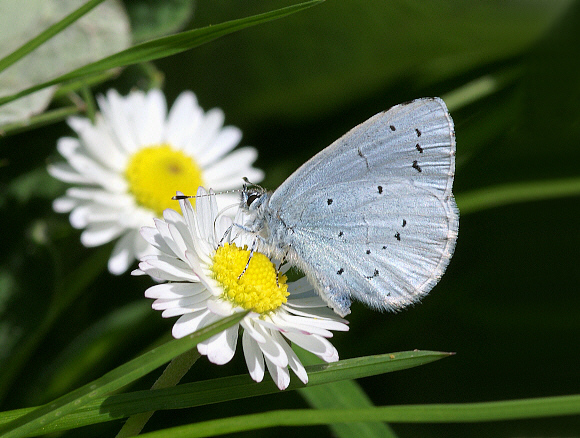 Holly Blue Celastrina argiolus, 1st brood male, Purbeck Hills, Dorset – Adrian Hoskins
Holly Blue Celastrina argiolus, 1st brood male, Purbeck Hills, Dorset – Adrian Hoskins
Introduction
This is a very widely distributed species, found throughout the temperate regions of Europe, in North America from Alaska to Panama, across temperate Asia to Japan, and in Africa north of the Sahara. Another very similar species Celastrina lavendularis is found in the temperate highland areas of India and south-east Asia, and 2 further Celastrina species are found in Indonesia and Papua New Guinea.
 Holly Blue Celastrina argiolus, 2nd brood female, Broughton Down, Hampshire – Adrian Hoskins
Holly Blue Celastrina argiolus, 2nd brood female, Broughton Down, Hampshire – Adrian Hoskins
The distinctive black wing-tips of the female ensure that it can’t be mistaken for any other European species, but the male can be confused in flight with the Common Blue, which also sometimes flies in scrubby habitats. The underside of the Holly Blue however is quite different, being a highly reflective silvery blue, with tiny black dots and dashes.
Like most British butterflies, the Holly Blue has had several earlier vernacular names which have since fallen into disuse. The male of this species was once called the Wood Blue or Azure Blue, while the female, which early entomologists thought was a different species, was known by the very apt and descriptive name “Blue Speckt Butterfly with Black Tips”.
Habitats
In Britain the Holly Blue is largely confined to England and Wales, although there are very sporadic records from Scotland and Ireland.
The butterfly is adapted to utilise a wide range of common larval foodplants including non-native ornamental species. Consequently it can be found in gardens and city parks as well as at woodlands, heaths, old quarries and railway cuttings.
Most habitats tend to be sheltered, but I have on several occasions seen pristine Holly Blues flying rapidly across open heathland e.g. in the New Forest ( Hampshire ) and Wareham Heath ( Dorset ). From the latter observation it is apparent that the butterflies are highly mobile, and able to colonise new sites quickly. This mobility and the polyphagous nature of the larvae, ensures that the species is widely and evenly distributed within its range.
Lifecycle
Throughout it’s range, the species is double brooded. In Britain, butterflies of the first brood begin emerging in March at the warmest sites, but April or May is more typical. The second brood flies from July until mid August. There is occasionally a partial third brood, emerging in September and October.
Older literature suggests that the butterfly oviposits on holly in the spring, and on ivy in the summer, but both broods in fact use a very much wider range of larval foodplants.
The eggs of the first brood are laid singly on flower buds of holly Ilex aquifolium, dogwood Cornus sanguinea, gorse Ulex europaeus, or buckthorn Rhamnus catharticus. The second brood oviposit on flower buds of ivy Hedera helix, privet Ligustrum vulgare, heather Calluna vulgaris, alder buckthorn Frangula alnus, bramble Rubus fruticosus, rowan Sorbus aucuparia and various other bushes and shrubs including cultivated snowberry and Pyracantha. The eggs are nearly always laid on bushes growing in warm sunny and sheltered situations. They hatch after about a week.
The green slug-like caterpillars feed nocturnally on the flower buds, developing seeds and berries of the various foodplants, and rarely on the young tender leaves. They habitually sit on the skin of a berry, with their head buried inside it. The caterpillar is easy to find, either by searching directly, or by looking for half eaten berries in which the caterpillar has left a distinctive circular hole.
As well as the plain green form of the caterpillar, there are also forms with prominent whitish and purplish markings. In common with most Lycaenids, the larvae are attended by various species of ants, which obtain sugary secretions from a gland on the caterpillar.
The larvae are parasitised by a host-specific ichneumon wasp Listrodomus nycthemerus, which has a very pronounced effect on Holly Blue abundance. In certain years, when climatic conditions favour the parasitoid, the butterflies can be extremely scarce. However when mild winters are followed by hot summers the wasps emerge out of synchrony with the caterpillars, and consequently in such years the butterflies are far more common.
The dark brown pupae are virtually impossible to find in the wild, but in captivity they are attached by a silken girdle to a twig or dead leaf. In nature they are probably formed in crevices in tree bark, or amongst leaf litter on the forest floor. The species over-winters in the pupal stage.
Adult behaviour
Most of the “blues” found in Britain and Europe form breeding colonies of dozens, hundreds or even thousands. They generally inhabit open grassy habitats and fly close to the ground. In contrast the Holly Blue is nearly always encountered singly, and found in the vicinity of bushes, shrubs and the lower branches of trees. It is also very unusual in that it is more commonly encountered in gardens and parks than in the wild countryside.
Holy Blues commonly feed on the aphid secretions ( honey dew ) which coats the upper surface of ash and oak leaves, but also sometimes settle on the ground to feed at bird droppings or imbibe moisture from damp paths. Additionally, in spring they nectar at hawthorn, daisies and wood spurge. The second brood nectars on a wider range of plants including bramble, hemp agrimony, fleabane, bell heather, cross-leaved heath, hogweed, cow wheat and burdock.
When feeding they always keep their wings closed, but in the hazy sunshine of early evening they often settle on bushes to bask, holding their wings partly open.
